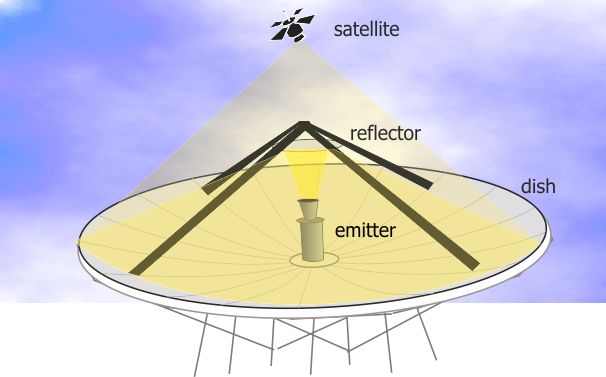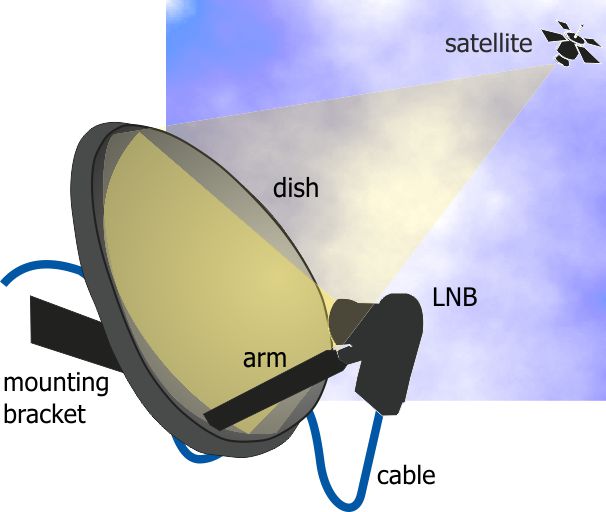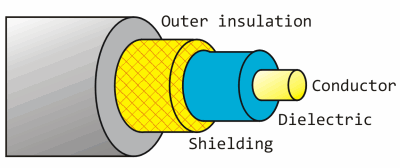Freesat reception - all about dishes
 Brian Butterworth published on UK Free TV
Brian Butterworth published on UK Free TV Satellite reception has both advantages and disadvantages compare with terrestrial (aerial) reception.
By using much higher frequencies (gigahertz, compared to terrestrial televisions megahertz) more transmission channels called transponders (the satellite equivalent of multiplexes) can be provided. For example, there are only six Freeview multiplexes, but Sky or Freesat users can access two hundred satellite transponders.
Aside from exceptional weather conditions (very heavy rain for example) digital satellite provides stable pictures and audio. Where Freeview transmitters are no more than 732 metres above sea level, the geostationary satellites used for television are 35,800,000 metres above the equator so reception is possible even where buildings, trees and hills make terrestrial reception impossible.

The downside of the transmitters being 22,300 miles up in the air is that the signals are very, very weak - so standard TV aerial is of little use. When the signals are sent to the satellites, huge dish transmitters are used to uplink the signal to the satellite. These are tens of metres from side to side, and feature an emitter that generates the signal, which is first bounced of a mirror (called a reflector) and then off the surface of the parabolic dish.

There are many satellites in the sky over the equator. Often these are in clusters over a particular position, for example there are four used for UK television are at 28.2 degrees east. There is another cluster over the 19.2 degrees east positions that are used for German television.
To receive these very weak signals from the satellite, it is necessary to use a dish for reception too. By using a reflective dish, this concentrates the signals onto a small device called a LNB. This is held in front of the dish by a metal arm.

The size of dish for reception is typically much smaller; often 60cm to 100cm in diameter, but the exact size depends upon the transmitting satellite transponder. To keep the transmission power levels down to levels that can be powered by the satellite's solar panels, each beam is focused on a particular area of the Earth's surface. If you are trying to receive the signal at the centre of this zone, a small dish is required. At the outer edges, you may need a 5 metre dish. Maps of these zones are provided by the satellite companies, and are called satellite footprints.
When the dish is installed it must be aligned carefully as the signal is very weak. The installer needs to know the inclination and the azimuth from the ground location to the satellite. If you install yourself you will find that there are markings on the dish that are used to point the dish in the correct position. It is important that the view of the satellite will not be blocked, so must take into account leaves growing on trees and potential building works.
For many people the LNB will have a single cable connected to it, however if you have Sky+ or a multi-room installation the LNB package will actually contain four receivers a quad-LNB. Unlike terrestrial television where you can split the aerial cable to feed more than one Freeview box or television set, with satelite reception you cannot. So, a Sky+ box with two receivers (so you can watch one thing and record another) has two cables connecting the box to the dish.
The cable that connects the dish to the receiver must be satellite grade cable. Whilst this looks superficially like the cable used to connect and aerial to a television, a higher grade cable is required for satellite reception.
Here is an image of a co-axial cable. This sort of cable is used to connect any type of receiving aerial to the reception equipment.

RG6, PF100 and PH100 are all types of coax cable that are suitable for the very weak signals that are received by a satellite dish. (The power is the same as you would receive from a one-bar electric heater on the moon).
The conductor in the centre passes the signals received from the dish to the set-top box. This is made from steel in RG6 cable, and from copper in the RF100 and PH100 types. This makes RG6 less suitable in the UK where rain can damage the cable.
The shielding is responsible for keeping unwanted external interference from damaging the signal. In the cheaper cable this will be a foil wrap, in better specified cables this is a braid (or mesh) of copper wires. The sheild in the RF100 covers 58% of the cable.
The non-conducting layer between the shield and the conductor is called the dielectric. This can be either a solid (RG6), foam (RF100) or air-spaced (PH100) dielectric. This makes the cables progressively more flexible (ie bendy without damage).
4:49 PM
viv : If all three TV receivers are definitely being used on Freesat ? (via a dish) and with each of the individual coax cables from them being connected into their respective ports on the dishes LNB, as satellite equipment "cannot" share a connection such as can be done on Freeview (via normal aerial), then your problem has to caused by something having happened to the coax feeds from the LNB that runs to each of the two secondary boxes.
You should temporarily try each of your boxes (if that's what you are using) on the satellite connection used by your main TV in order to ensure that they are still fully operational, or alternatively if your large TV does not have Freesat built in and is being used in conjunction with a Freesat box? try this box on each of the coax feeds used by your two secondary Freesat devices.
Further advice dependant on feedback.
| link to this comment |
8:37 PM
how can I use a sat dish to cover 2 televisions and a dvd player/recorder
| link to this comment |
9:01 PM
stuart: Every satellite device device being used on a dish system requires its own individual connection into the LNB on the end of the dish arm, as satellite devices communicate with the LNB for band switching as well as polarity changing, likewise would clash with each other if they shared a connection.
| link to this comment |
9:08 PM
stuart: As JB38 points out, you basically can't. If either of the TV's have a Freesat/generic sat. tuner in them (2013 and 2014 Sony/LG's and some Samsung's/Panasonics), then you can at least you a normal dish with a single LNB.
The recorder could use a sat. box to record from, but basically, you need to get some means of decoding the signals from the dish, and as JB38 points out, you need an LNB for each device.
| link to this comment |
9:32 PM
stuart / MikeB: Just to clarify on a point concerning the LNB. Although I did of course mention that each device requires it own connection into the LNB, if though the LNB fitted on the dish is of the older single output port type then this can be changed for a four output quad block, quad LNB kits being available via e-bay sources for as low as around £10.00 or so, all that's then required being a coax run from each of the output ports to the wherever each of the satellite devices are being used.
A point to note though, modern twin tuner Freesat recorders require two feeds, this being for the obvious reason of one being required for each tuner.
| link to this comment |
9:58 AM
jb38: Totally agree. The dish part isn't that difficult (at least in theory!), its the boxes at the other end as well. Dish systems are great in many ways, but they are a bit less flexible than Freeview.
| link to this comment |
11:16 AM
MikeB & jb38:
Whilst totally agreeing with the details of your discussion, there is another possibility - a loft distribution system that takes inputes from the LNB and distributes the various signals to different points in the house. One such is at Labgear others are available. As you probably know already, these take the signals from the LNB, preferrably from a quad with all four connected to the switch, and re-distributes the various IF signals to the TV sets or boxes. The switch sorts out the polarities, etc and hence if best with all four inputs being fed from the dish.
Just a thought.
| link to this comment |
1:22 PM
Stuart/jb38/MikeB & P
Stuart hasn't actually said if his 2 TVs (1 tuner each) and DVD recorder (1 or 2 tuners) have satellite tuners. If they do then a quad LNB plus separate satellite quality coax cable to each tuner is all he needs. If not then he needs to give us more details.
| link to this comment |
1:28 PM
No signal
Fault No 25 appears this is now happening
Regularly. I've had satellite since inception
And for over 20years no problem, now I'm told by sky must be
Bad weather. An engineer re set the dish but
It's away again and the weather is fine. Why is weather affecting this
Now. I think it's just a scam so sky can charge £65 per call out
Doug
| link to this comment |
6:00 PM
Neil Bell: You are of course quite correct on this point, insomuch that Stuart hasn't actually mentioned anything about his set up apart from having a dish as well as two TV's and a DVD player / recorder, and so rather than having automatically assumed that Freesat capable devices were being referred to, should really have requested info on the TV's and DVD recorder in question prior to bringing up the subject of the dish, as I do admit to having a suspicion that said by yourself possibly applies.
Still, all will be clear when / if Stuart replies.
| link to this comment |